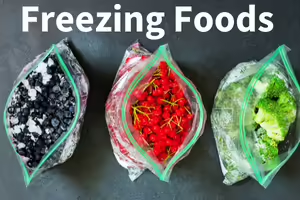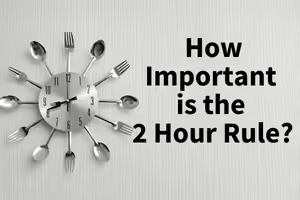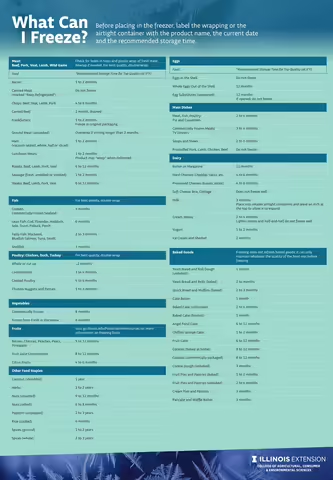Keeping Food Cold
Keep Cold Food Cold to Prevent Foodborne Illness
Refrigerating food is important to slow the growth of harmful bacteria. Make sure the refrigerator is set at 40 degrees or below. Find out more information about refrigerator storage on our storing food website
Perishable food such as meat, dairy, most fruits, and vegetables should not sit at room temperature for more than 2 hours. Place on ice or in the refrigerator. To prevent the growth of harmful bacteria, it's important to control temperature and keep cold food cold. Read more below about how to safely freeze and thaw foods. Remember thawing meat in a slow cooker is not a safe practice.
Additional Resources for Keeping Food Cold

Blanching and Freezing Vegetables
Learn how to safely freeze and blanch vegetables
Freezing Foods
Find the basics on how to freeze food, what containers to use, and more!
The Two Hour Rule
Read a blog about why food shouldn't be left at room temperature
Do I Need to Refrigerate My Pie?
Read about what desserts need to be refrigeratedHave Extra? Freeze it for Later.
When stocking up on food becomes a necessity, you’ll want to put your freezer to good use. Freezing is one of the easiest ways to store food for longer periods of time. Read our free tip sheet on what you can freeze
Basic Steps for Freezing
- Freeze food within a few days, making sure that potentially hazardous food, such as raw meat or cooked food, was never left at room temperature for more than 2 hours.
- Use proper packaging that is safe for the freezer. Use smaller containers, no more than 4-inches deep, to maintain quality and prevent ice crystals from forming.
- Ensure proper airflow by allowing space around the container when placing it in the freezer.
- Check your freezer temperature and maintain the freezer temperature at 0 degrees Fahrenheit or less to freeze the food rapidly.
Important Steps for Freezing Produce
- Wash and drain produce before removing cores, pits, seeds, skins, etc. Wash small amounts at a time through several changes of cold water. Do not let the produce soak.
- For fruits, determine how to prevent discoloration, if needed, and select your packing type. Most fruits have a better texture and flavor if packed in sugar or syrup.
- For vegetables, following appropriate blanching times and cool quickly by plunging into cold ice water, then drain. Blanching is to scald vegetables in boiling water or steam for a short time. Determine if you are doing a dry or tray pack.
- Pack in proper containers, leaving sufficient space between the top of the packed food and the closure of the container.
- Label the container with the product name and the current date, and freeze at 0°F or below for 8 to 12 months for best quality.
Selecting Proper Containers
Place food in airtight containers made of plastic or glass, such as plastic freezer containers with tight-fitting lids or wide-mouth canning jars. Do not use regular glass jars; they break easily at freezer temperatures.
Another option is to use plastic freezer bags and moisture-vapor resistant wrapping materials, such as plastic freezer wrap, freezer paper, and heavy-duty aluminum foil, which are suitable for dry-packed foods with little or no liquid. Press to remove as much air as possible before closing.
Before placing in the freezer, label the wrapping or the airtight container with the product name, the current date and the recommended storage time.
Thawing Foods Safely
Thaw using one of the four safe methods:
- In the refrigerator.
- In a leak-proof plastic bag immersed in cold water, and change water every 30 minutes.
- In the microwave and cook it immediately after it has been defrosted.
- During the cooking process, such as frozen hamburger patties on the grill.
Never thaw foods outside or in a garage, basement, or on the kitchen counter. These methods can leave your foods unsafe to eat. Once food is thawed in the refrigerator, it is safe to refreeze it without cooking. However, the quality may suffer due to the loss of moisture when thawing. After cooking raw foods which were previously frozen, it is safe to freeze the cooked foods.
Freezing at the Right Time
If you know you won’t be using raw meats within a few days, put them in the freezer to keep them from spoiling:
- Ground meat within 1-2 days.
- Poultry (whole or pieces) within 1-2 days.
- Roasts, steaks or chops within 3-5 days.
- Fish within 3-4 days.
- Cooked leftovers within 3-4 days.
Making Smart Choices
While many foods freeze well, some have a proven track record as holding up poorly when frozen.
- High-water content vegetables, such as lettuce, celery, cucumbers, and radishes break down when frozen.
- Potatoes may darken and change texture when included in soups and stews.
- When frozen alone and not as an ingredient within a dish, half-and-half, sour cream, mayonnaise, and cottage cheese often become grainy or watery.
- When frozen alone, cooked pasta products lose texture.
- Gelatin and gelatin dishes weep when thawed.
- Cooked egg whites become tough and rubbery.
Freezing Food FAQs
Can I freeze milk? Yes. Place into smaller airtight containers and leave an inch at the top to allow it to expand. Use within three months for best quality.
Can I freeze eggs? Eggs can be stored in the refrigerator for at least one month. To store longer, crack eggs and mix the yolks with the whites. To prevent graininess, add 1 tablespoon sugar or ½ teaspoon salt per one cup of egg mixture. Strain through a colander to improve uniformity. Allow an inch at the top of the container. Do not freeze eggs in the shell.
Can I freeze cheese? Yes, you can freeze hard and semi-hard cheeses. For best results shred cheese or slice into small pieces before freezing. Cheese food products, such as sauces, dips, and processed cheeses usually freeze fine. Soft cheeses do not freeze well.
Can I freeze bread? Yes. For commercial packaged bread or homemade bread, place in a heavy-duty freezer bag and freeze for up to 3 months for best quality.
